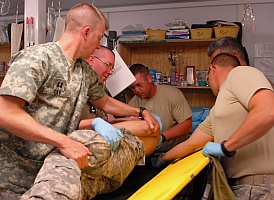 Scientists at Albert Einstein College of Medicine of Yeshiva University in New York have used nitric oxide particles reduced to nanoscale size to improve survival after life-threatening blood loss. Their results were reported in the 21 February online edition of the journal Resuscitation (paid subscription required).
Scientists at Albert Einstein College of Medicine of Yeshiva University in New York have used nitric oxide particles reduced to nanoscale size to improve survival after life-threatening blood loss. Their results were reported in the 21 February online edition of the journal Resuscitation (paid subscription required).
Nanoparticles — particles measured in nanometers, or billions of a meter — containing nitric oxide (NO) were infused into the bloodstream of hamsters that had lost half their blood volume, where the particles helped maintain blood circulation and protect vital organs. The therapy counters hemorrhagic shock from massive blood loss by increasing the body’s levels of NO gas, which relaxes blood vessels and regulates blood pressure.
Albert Einstein professor and co-author Joel Friedman believes this advance, if translated into therapies for humans, could improve battlefield and trauma care. Hemorrhagic shock is best treated with infusions of refrigerated blood and other fluids, but these additional supplies are usually limited to emergency rooms or trauma centers.
“It is highly impractical to pack these supplies for use in rural emergencies, mass-casualty disasters, or on the battlefield,” says Friedman. “Our nanoparticle therapy may offer the potential for saving lives in those situations. It’s lightweight and compact and doesn’t require refrigeration.”
Read more: Research Institutes Collaborate on Cancer Nanomedicine
* * *

 RSS - Posts
RSS - Posts
You must be logged in to post a comment.